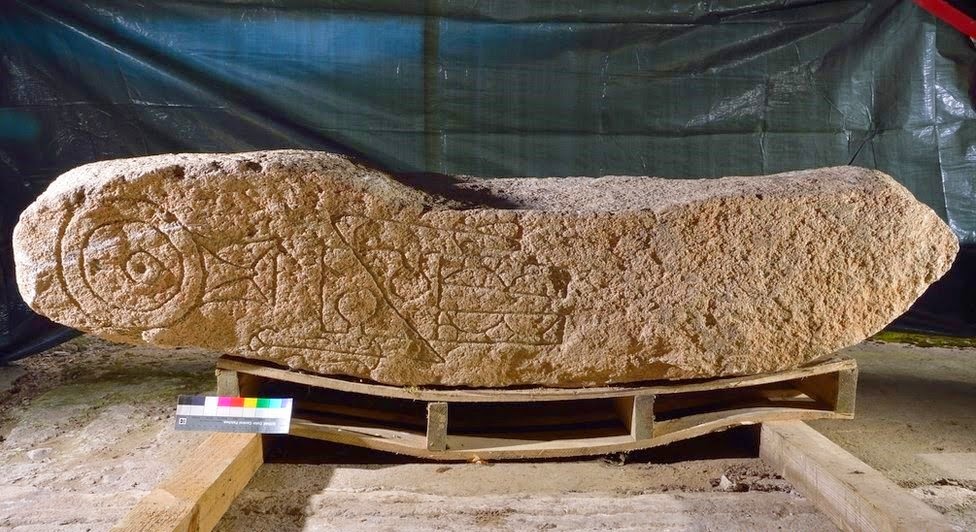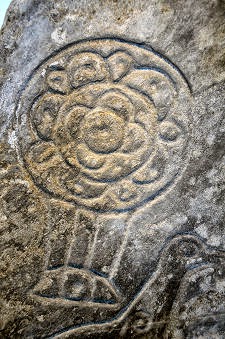La lingua Pittica (Pictish) è persa e sconosciuta. Un eccezionale ritrovamento ha permesso di aggiungere un raro reperto ai pochissimi esistenti fino ad oggi.
Si tratta di un pezzo di granito di circa 1,70 mt e pesante circa una tonnellata.
Archaeologist try to unlock secrets of Pictish stone
Archaeologists have released details on what they have described as the most important Pictish stone find to have been made in Moray in decades.
 |
The Dandaleith Stone [Credit: Aberdeenshire Council Archaeology Service]
|
Weighing more than a ton and stretching to 1.7m, the Dandaleith Stone dates from the 6th to 8th Centuries and was uncovered during the ploughing of a field near Craigellachie in May 2013.
Because of sensitivities around the location as well as the issue of having to work out how to remove a stone of its size - and where to move it to - archaeologists have revealed little about the find until now. The stone was removed from the field in April this year and taken to the Graciela Ainsworth Sculpture Conservation workshop in Leith for assessment.
Once this work is completed, the stone will be put on display at Elgin Museum, possibly next year. The precise location where the stone was found remains secret to allow archaeologists to investigate the site for further artefacts.
Archaeologists are not sure at this stage if the stone was found at the its original location. The site is on the River Spey floodplain, so it is possible that it may have been washed down from another place.
Archaeologists said that a flood in 1829 called the Muckle Spate would have been powerful enough to shift the pink granite boulder. However, the stone and its carvings are in good condition suggesting it was erected where it was found and not tumbled around in a serious flood.
Claire Herbert, regional archaeologist at Aberdeenshire Council Archaeology Service, said: "Members of the public regularly contact the Archaeology Service about artefacts they have found, but the reporting of the Dandaleith Stone was something truly unexpected, a real rarity. "I would like to thank the ploughman and landowner for reporting their find to us, and for their continued help and co-operation.
"To our knowledge, this is a truly unique find which has the potential to alter our understanding of Pictish Symbol Stones. We are privileged to be involved in the continued
protection of such a wonderful object."
It has incised decoration on two adjoining faces. The other two faces show no obvious signs of carving. Face one is carved with a large eagle, a crescent and what archaeologists call a V-rod. On face two are mirror case, notch rectangle and Z-rod symbols.
These are typical Pictish symbols, archaeologists said.
Symbol stones have been found previously at Arndilly and Inveravon.
 |
| Disegno della pietra diArndilly |
 |
| Pietra di Inveravon (sopra) e dettaglio del mirror case (sotto) |
Janet Trythall, vice-president of The Moray Society, said: "We are thrilled at Elgin Museum to have been allocated this fantastic Pictish stone. "It will be a marvellous complement to our existing collection of carved stones and an attraction for a wide range of visitors. "All that remains is to raise the necessary funding for restoration and display, and to overcome the logistical challenges of a piece of granite of this magnitude."
Source: BBC News Website [August 08, 2014]
Read more at: http://archaeologynewsnetwork.blogspot.it/2014/08/archaeologist-try-to-unlock-secrets-of.html?utm_source=feedburner&utm_medium=feed&utm_campaign=Feed:+TheArchaeologyNewsNetwork+(The+Archaeology+News+Network)#.U-j_Myh7DfU
Follow us: @ArchaeoNewsNet on Twitter | groups/thearchaeologynewsnetwork/ on Facebook


